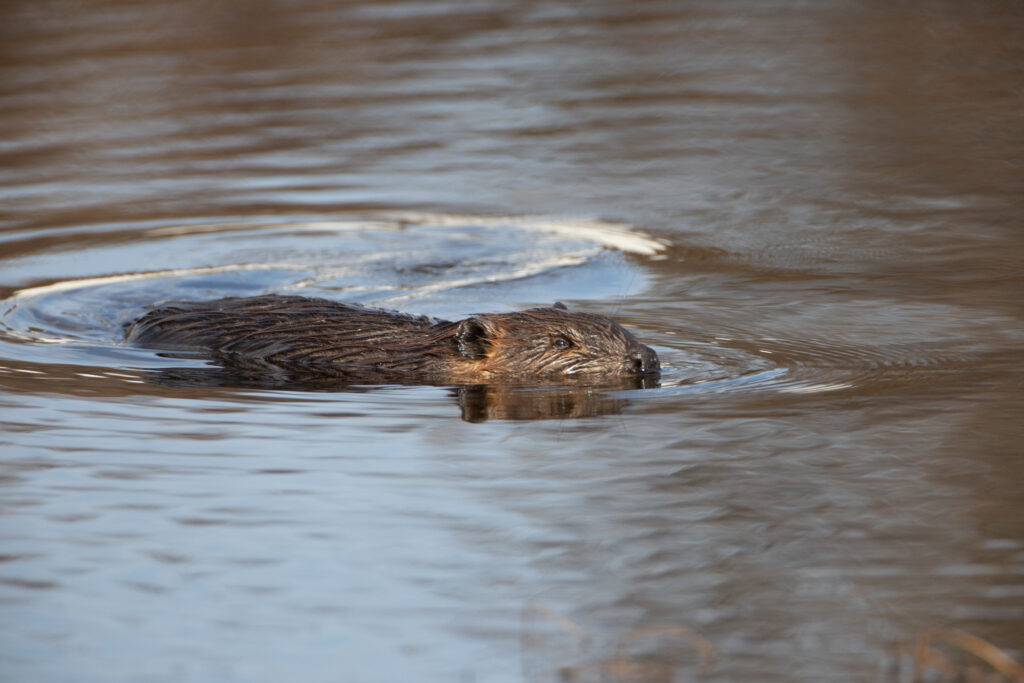A beaver swims in a tundra pond in the Nome area on June 12, 2018. As the climate has warmed, beavers have moved north into tundra terrain in both Alaska and Canada. A National Science Foundation-funded program, the Arctic Beaver Observation Network, is examining the myriad aspects of that trend. (Peter Pearsall/U.S. Fish and Wildlife Service)
Oregon’s state animal has for years been classified as a “predator” by the state fish and wildlife agency, and that’s meant that the North American Beaver has lived largely unprotected from private landowners who can kill them at will.
That will change July 1 when new rules go into effect under House Bill 3464, the “beaver bill.” The bill passed the state Legislature in 2023, and the Oregon Fish and Wildlife Commission, which crafts regulations for the Oregon Department of Fish and Wildlife, approved new rules June 14 to reclassify and protect beavers from being killed at will by private landowners.
The beavers will now be classified solely as “furbearers,” an animal whose fur has commercial value, and no longer be classified as “predators.”
With this change, landowners can’t kill a beaver for being a nuisance, or because they’re worried the animal will gnaw through plants or crops. To kill a beaver, the landowner must go through a permitting process with the Fish and Wildlife Department, which will require the landowner to undertake non-lethal mitigation strategies first. These include placing fences and barriers around trees, repellent on trees and choosing different types of plants, according to Michelle Dennehy, a spokesperson for the agency.
The bill won’t affect the killing of beavers for their furs during the hunting season, which runs from Nov. 15 to March 15. It also won’t affect beaver trapping on public lands. Conservationists have over the last four years called on state and federal agencies to end the practice on state and federal lands.
Beavers are considered ecological engineers because of their ability to construct dams and create ponds. They can help manage water issues related to drought but they can also cause flooding and damage trees. They’re the largest rodent in North America, weighing between 35 and 65 pounds and measuring 2 to 3 feet in length in adulthood.
By the late 1800s, the North American Beaver was nearly extinct in Oregon due to fur trapping, according to the state Department of Fish and Wildlife. Their numbers across the continent have climbed in the last century from around 100,000 to about 15 million, today. There is no estimated population figure in Oregon.
For private landowners, some exceptions to the new permit requirement will exist. If a beaver’s gnawing, digging or dam building is “imminently threatening” to infrastructure or crops, or is damaging – or has the potential to damage – trees owned by small timber landowners, landowners can get permission from the agency to kill the animals without a permit.
Even in an instance when the state Fish and Wildlife Department determines a permit is not necessary, anyone who kills a beaver will have to report it to the agency, enabling it to collect data on all beaver kills in the state for the first time. The agency will also for the first time collect more detailed data on what kinds of damages beavers tend to be most responsible for, where beavers are distributed across the state, where conflicts have a pattern of arising and when and why Oregonians kill beavers.
The agency does not have much data on beaver kills and deaths each year, according to Dennehy, but the latest rules will change that. Beavers killed with a permit for their fur have remained low over the past decade, she said. An average of 1,100 beavers in Oregon have been killed each year between 2020 and 2023 for their fur.
GET THE MORNING HEADLINES DELIVERED TO YOUR INBOX
The post No longer considered predators, Oregon beavers get new protections from state appeared first on Oregon Capital Chronicle.

